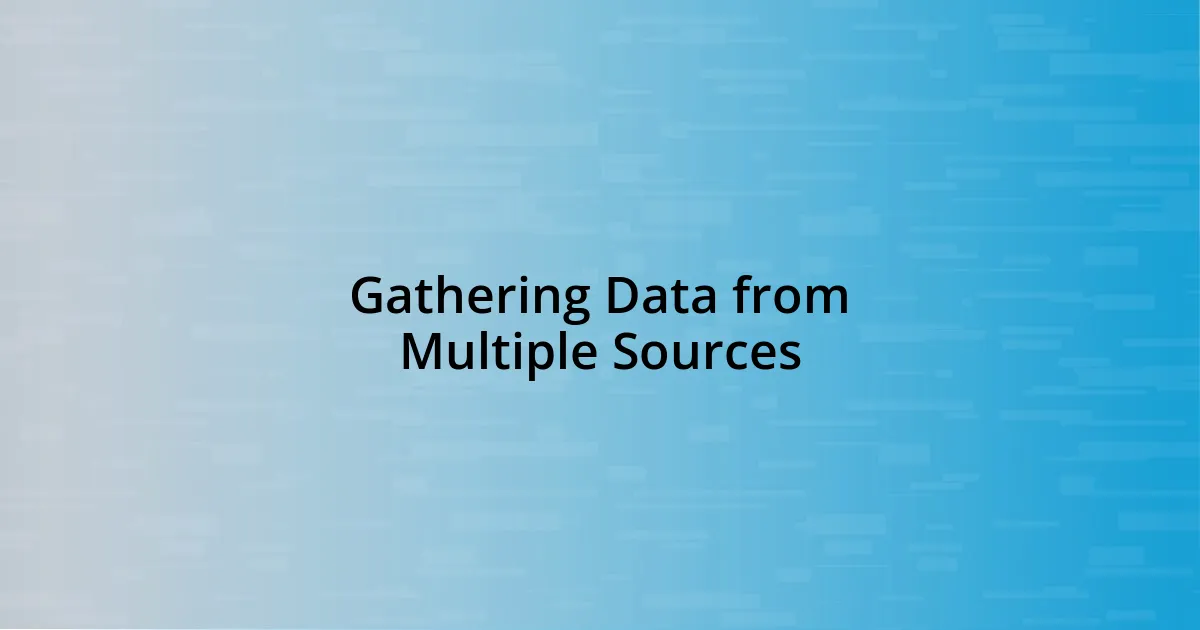Key takeaways:
- Analytics transform raw data into actionable insights, enabling better understanding of customer behavior and enhancing strategic decisions.
- Identifying key metrics like engagement rate and conversion rate is crucial for focused analysis and informed actions.
- Gathering data from multiple sources creates a comprehensive narrative, illuminating customer behaviors and guiding strategic adjustments.
- Combining intuition with data-driven approaches fosters creativity, encourages experimentation, and improves overall decision-making processes.

Understanding the Role of Analytics
Analytics play an essential role in transforming raw data into actionable insights. I remember a project where analyzing customer behavior patterns revealed unexpected trends. It was eye-opening to see how shifts in preferences could lead to new opportunities for engagement.
Have you ever felt overwhelmed by the sheer volume of data available? I certainly have. But it’s through the lens of analytics that I’ve been able to distill that complexity into meaningful narratives that drive decision-making and strategy. Seeing data transform into a clear story is one of the most rewarding aspects of my work.
When I first began utilizing analytics, I underestimated its power. Initially, numbers felt abstract, but as I delved deeper and uncovered connections, that mystique unraveled. Harnessing analytics allows me to not only better understand my audience but also to measure the impact of my decisions, creating a feedback loop that enhances future strategies.

Identifying Key Metrics for Insights
Identifying the right key metrics is crucial for deriving meaningful insights. From my experience, focusing on metrics that align with your objectives can significantly enhance the effectiveness of your analysis. For instance, during a digital marketing campaign, I honed in on engagement rate and conversion rate, which helped me understand how well my audience responded to different strategies and content.
Moreover, it’s also important to differentiate between leading and lagging indicators. In my journey, I often emphasize leading indicators, as they provide proactive insights, allowing me to adjust my approach in real time. For example, tracking website traffic could inform me about emerging trends before they are reflected in sales data, enabling me to pivot strategies promptly and stay ahead of the curve.
Reflecting on my past projects, I’ve learned that not all metrics are created equal. I recall a time when I was inundated with various performance measures, each vying for my attention. By narrowing my focus to a select few that truly mattered, such as customer lifetime value and churn rate, I felt a real sense of clarity. It’s liberating to identify and concentrate on what genuinely drives success, rather than getting lost in a sea of numbers.
| Metric | Purpose |
|---|---|
| Engagement Rate | Measures the interaction level with content. |
| Conversion Rate | Tracks the percentage of visitors completing desired actions. |
| Customer Lifetime Value | Estimates total revenue from a customer over the entire relationship. |
| Churn Rate | Indicates the percentage of customers who stop using the service. |

Gathering Data from Multiple Sources
Gathering data from multiple sources is like weaving a tapestry. Each thread contributes to a more elaborate picture, illuminating insights that may not be visible when viewed in isolation. I remember a specific instance where I integrated data from social media, email campaigns, and website analytics. The intersection of those sources unveiled patterns in customer behavior that sparked my creativity and encouraged innovative strategy adjustments.
Here are some key sources I often pull data from:
- Website Analytics: Provides insights into user behavior, traffic sources, and engagement levels.
- Social Media Platforms: Offers feedback and sentiment around your brand while delivering real-time trends.
- Customer Relationship Management (CRM) Systems: Centralizes customer interactions, helping with sales and relationship insights.
- Email Marketing Metrics: Reveals open and click-through rates, informing engagement strategies.
- Market Research Reports: Supplies industry context and competitor benchmarks to evaluate positioning.
These diverse data points, when combined, not only help in forming a clearer narrative but also evoke excitement as I piece together the behaviors and preferences of my audience. It’s rewarding to see how a well-rounded approach can drive informed decision-making.

Analyzing Data Trends and Patterns
When I analyze data trends and patterns, I look beyond just the numbers; I seek the stories they tell. I recall a time when I noticed a sudden dip in website traffic during a particular month. Instead of brushing it off as a seasonal fluctuation, I dove deeper, segmenting the data to discover that a recent change in search engine algorithms had impacted my visibility. This experience taught me the value of contextual understanding—numbers, after all, are simply reflections of real-world behavior.
One standout moment for me was when I started using visualizations to identify trends. By creating compelling graphs and charts, I made it easier for myself and my team to spot correlations at a glance. For instance, a line graph revealing a steady increase in mobile users interacting with our content helped steer our marketing efforts towards mobile optimization. It was fascinating to observe how a mere visualization transformed our strategic direction, making complex data more accessible and actionable.
As I reflect on my analytics journey, I often ask myself: What are the underlying patterns behind my metrics? This curiosity drives me to continuously explore data for hidden insights. Like a detective piecing together clues, I once discovered that a specific demographic was more responsive to our campaigns on Fridays. This revelation not only spurred a change in our posting schedule but also ignited excitement within the team, fostering an atmosphere of collaboration and creativity. The thrill of uncovering trends makes the analytical process rewarding, bridging the gap between raw data and impactful decision-making.

Visualizing Data for Better Understanding
Visualizing data is like translating complex concepts into a language that everyone can understand. I vividly remember the first time I created an interactive dashboard for my team. Suddenly, what once felt overwhelming—rows of numbers and disjointed statistics—transformed into colorful graphs and visual cues that painted a clear picture of performance trends. The room buzzed with excitement as we explored the data together, sparking lively discussions on strategies that felt grounded in a shared understanding of the visuals.
One remarkable instance was when I used a heat map to analyze user engagement on our website. I was astounded to see certain areas lighting up with activity, while others remained dim and neglected. It prompted me to ask, “What if we could optimize these overlooked sections?” That question led us to reimagine our content layout, focusing on those hotspots. Emotionally, there’s a rush that comes from seeing abstract data materialize into tangible action steps, igniting both creativity and clarity in strategy.
I often find myself reflecting on why some visualizations stick with me while others fade. Is it the story they tell or the clarity they provide? For example, using infographics to summarize multifaceted reports has always resonated with me; they distill essential insights into easily digestible snippets. There’s a unique joy in designing these visuals, knowing they can influence an audience’s comprehension and, ultimately, their decisions. In this journey of data exploration, I’ve discovered that visualization is not merely a tool; it’s a bridge between confusion and enlightenment, sparking curiosity and deeper engagement with the information.

Making Data-Driven Decisions
When it comes to making data-driven decisions, I’ve learned the importance of blending intuition with analytics. I remember an instance where a hunch guided me to explore customer feedback more deeply. The initial numbers suggested we were doing well, but the comments revealed discomfort around a new feature. Listening to those voices, I shifted our focus and fine-tuned the product, ultimately improving user satisfaction. Isn’t it fascinating how data can illuminate both the quantitative and qualitative aspects of a situation?
I’ve found that framing decisions as experiments can truly unleash the power of data. This approach influenced a marketing campaign where we ran A/B tests on different ad creatives. One version sparked engagement, while the other fell flat. It was exhilarating to watch live data unfold, confirming our hypotheses and showcasing what resonated with our audience. This not only refined our strategies but also fostered a culture of experimentation within my team. How often do we shy away from such bold moves due to fear of failure?
Revisiting past decisions can be just as enlightening as making new ones. I often analyze previous campaigns to see where I could have leveraged data more effectively. One time, after reflecting on a stagnated project, I realized that I hadn’t fully taken advantage of segmentation data. This epiphany reinforced my commitment to continuous learning and adaptation—the more I embrace the lessons data offers, the more informed my future choices become. Do you think our past experiences shape our present decisions more than we might recognize?

Reviewing and Adjusting Your Strategy
When I review my strategies, I often feel like I’m embarking on a treasure hunt for insights. For instance, I recall a quarterly review meeting where I pulled up performance metrics and felt a wave of realization wash over me. Some campaigns weren’t just underperforming; they were revealing the wrong target audience. I remember thinking, “How could I have missed that?” This prompted me to pivot our focus and reassess our customer personas, laying the groundwork for more impactful engagements moving forward.
Adjusting strategies based on analytics can be an emotional rollercoaster. There was this one time when a data report highlighted a significant drop in engagement, and I felt an immediate sense of frustration mixed with determination. I knew I had to dig deeper. By segmenting the audience further, I uncovered that our messaging was resonating less with newer customers than with long-time followers. It was a tough pill to swallow, but it empowered me to create more tailored content, ultimately revitalizing our outreach efforts. Have you ever faced a similar moment where diving into the data changed your perspective entirely?
I’ve come to appreciate that the key to effective strategy adjustments lies in a balance between numbers and instinct. I remember a specific moment during a campaign when I instinctively decided to tweak our messaging just based on gut feeling. Meanwhile, the analytics were indicating a downward trend. Surprisingly, after implementing the change, our engagement soared! This taught me that sometimes, trusting that little voice inside, coupled with analytical evidence, can lead to those game-changing adjustments. Isn’t it incredible how both numbers and intuition can guide us toward greater success?















